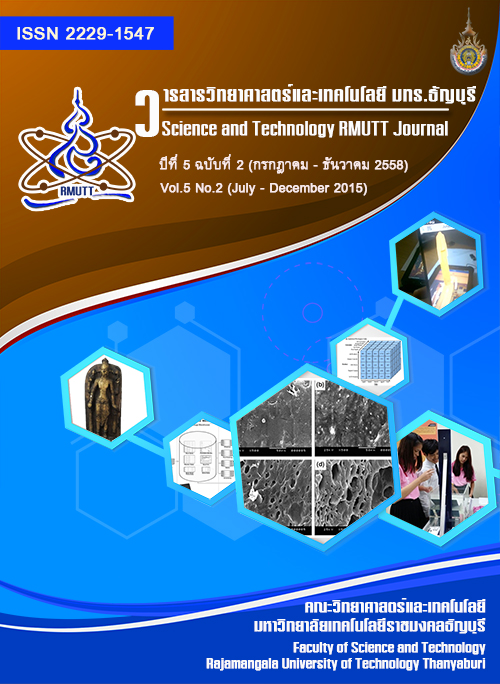A Simple Experimental Set for Refractive Index Measurements of Liquids
Main Article Content
Abstract
The objectives of this work were to reconstruct the simple refractive index experimental set using Snell’s law and refracted light through different media and to study the efficiency of them. It was apparently comfortable and easy to use. It is consisted of: 1) an acrylic box and LASER source, 2) the acrylic box that connected with a scale meter ruler and 3) the plate mirror which could be varied horizontal angel for using. In finding the efficiency by using the simple experimental set, send the light from LASER source trough the desired liquid in box after that had refracted in the air. The refractive index was calculated from the data of the horizontal distance between the refract light position on the plate mirror to the scale ruler , the height distance from the refracted light position on mirror to refracted light position on the scale ruler and the horizontal angel of the plate mirror. The excellent of the simple experimental set was the horizontal angel can be varied. The using of the simple refractive index experimental set found the refractive indices of 4 types of liquids; water, glycerin, 50% of syrup and palm oil. The results revealed that the refractive indices of water, glycerin, 50% of syrup and palm oil were 1.244-1.286, 1.346-1.558, 1.286-1.328 and 1.323-1.584, respectively. The error percentage of this simple refractive index experimental set was less than 10 %.
Article Details
References
2. Ismo T.Koponen and Terhi Mantyla, “Gererative role of experiments in physics and in teaching physics: A suggestion for epistemological reconstruction” unpublished.
3. Phewphong tammanon and Nirun Witit-anun,“Measurement of Refractive Index of Liquid by Refracted Light Technique”. Graduate Research Conference 2013.Khon Kaen University. p291-295.
4. Mohnlal.S.K.“A simple method for refratative index measurements for liquids,” Current Science,.57( 14),1988. p791-793.
5. KS. Kumar, “Refractive index of liquids by measuring displacement of refracted laser beam,”Research Journal of Physics Sciences,1(8), 2013.p6-9.
6. Ariponnammal S., A Novel Method of Using Refractive Index as a Tool for Finding the Adulteration of Oils Research Journal of Recent Sciences, 1(7), 2012.p77-79
7. Khanna D.R. and Gulati H.R. “Founamentals of opictcs”.R.Chand and Co Publishers, 12th ed. 1985.
8. Marcelino Anguiano-Morales, Didia P. Salas Peimbert, and Gerardo Trujillo-Schiaffino. “The use of a conical lens to find the refractive index of liquids”. Journal of Physics: Conference Series 274, 2011.
9. F.N. Ngassapa and O.C. Othman. “ Physicochemical characteristics of some locally manufactured edible vegetable oils marketed in DAR ES SALAAM ”. Tanz.J.Sci.Vol.27, 2001
10. D.Sokoloff and R. Thornton, “Using interactive leacture demonstrations to create an active learning environment”, The Physics Teacher 35, 1997. p340-347
11. Edward F. Redish, “The implications of cognitive studies for teacniing physics,”American Journal of Physics 62, 1994. p796-803.
12. Edward F. Redish, “Millican lecture 1998: Building a science of teaching physics”, American Journal of Physics 67, 1998.p562-573
13. A.Van Heuvelen, “Leraning to think like a physicist : A review of research based instructional strategies,” American Journal of Physics 59, 1991.p 891-897
14. L.Mcdermott, P.S.Shaffer and C.P. Constantinou, “Preparing teachers to teach physics and physcical science by inquiry,”Physics Education35, 2000.p411-426
15. D.Hammer, “More than miscoceptions: Multiple perpectives on student knowledge and reasoning, and an appropriate role for education research,” American Journal of Physics 64, 1996.p1316-1325


